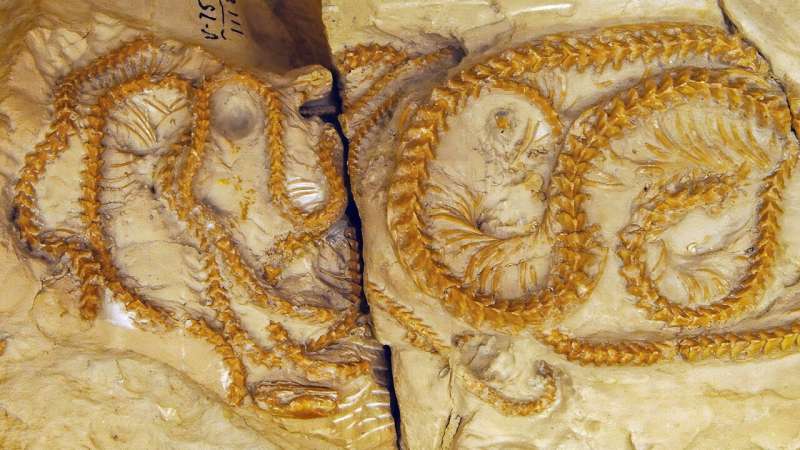This article has been reviewed according to Science X's editorial process and policies. Editors have highlighted the following attributes while ensuring the content's credibility:
fact-checked
peer-reviewed publication
trusted source
proofread
New fossil snake species provides insight into reptile social behavior and development

A newly discovered snake species, Hibernophis breithaupti, provides rare insight into the social behavior of snakes and fills some gaps in our knowledge of the evolution of boas, or boidae. The quartet of fossilized snakes discovered in western Wyoming dates back 38 million years.
The findings are published in the Zoological Journal of the Linnean Society.
The snake specimens were preserved in a cluster within a hibernaculum, a space where animals shelter together during colder months. The position in which the specimens were found "represents social behavior in snakes, which is something that we don't often see," Michael Caldwell explains. According to Caldwell, a professor in the Faculty of Science, this is the first clear evidence of reptilian social behavior in the fossil record.
This behavior also sets this new species apart from other reptiles. Though many mammals hibernate during the winter, only one species of snake is known to follow suit: the garter snake. "This is really unusual for reptiles. Of the almost 15,000 different kinds of reptile species alive today, none of them hibernate in the way that garter snakes do."
In addition to being an indication of snakes' social behavior, the practice of gathering in a hibernaculum is an adaptation that allows garter snakes to survive in colder climates. "They can't regulate their body temperature so they need to find a way to conserve as much heat as they can through the winter and they do this by forming these big masses," says Caldwell.
While this particular hibernaculum featured just four fossilized snakes, modern garter snakes gather in the hundreds or even thousands. Their adaptation is so well known, Caldwell explains, that sometimes clever solo snakes from other species, such as rattlesnakes, will hide among the garter snakes, benefiting from the group's protection.
The ancient snake specimens were also articulated, meaning they were found in one piece with the bones still in the proper order, which is extremely uncommon. "There are probably, in the world's museum collections, nearly a million disarticulated snake vertebrae. They are easy to find. But finding the whole snake? That's rare."
The articulated specimens give us a better understanding of the evolution of boidae, a family of snakes with more than 50 species, including burrowing boas like Hibernophis breithaupti. One of the snakes within the quartet is approximately twice the size of the others, allowing the researchers to see the same species of snake at different stages of development.
"We learn quite a bit more about boidae evolution in the broad sense," says Caldwell. "It seems that they probably started out as relatively small-bodied snakes, which is interesting."
The skulls are a key area to gauge growth and development. Just as the proportions of head to body change dramatically in humans from infancy to adulthood, a snake's skull and head-to-body proportions change over its lifespan. Since snake skulls are very thin and delicate, though, they're typically not preserved well enough to track that progression.
These new specimens also indicate how a snake's vertebrae differ in shape and size based on where on the body they are located. Even a small snake has anywhere from 200 to 400 vertebrae, which commonly get separated and scattered in different areas before fossilization occurs. The ability to see the entire spine is a valuable reference point.
Caldwell says it raises the question of whether bones previously ascribed to new species were indeed new. Perhaps particular vertebrae clusters just gave that impression, but actually came from different parts of the fossilized spines of the same species.
These rare articulated snake specimens have remained so remarkably well preserved for tens of millions of years because of their location. As Caldwell explains, 38 million years ago, when these particular Hibernophis breithaupti snakes were alive, the Southern Basin and Range Volcanic System was incredibly active and emitting huge quantities of volcanic ash.
The ash settled and helped preserve the bodies of the creatures, which were found in a matrix of "fine, sandy mudstone" typical of the White River Formation, according to the paper the researchers published about the fossil find. The researchers speculate that the animals fell victim to a "small flood episode."
"They were preserved in a very unusual circumstance, geologically speaking," says Caldwell. "Fossilization is a rough process. You need exactly the right conditions to preserve something."
More information: Jasmine A Croghan et al, Morphology and systematics of a new fossil snake from the early Rupelian (Oligocene) White River Formation, Wyoming, Zoological Journal of the Linnean Society (2024). DOI: 10.1093/zoolinnean/zlae073
Journal information: Zoological Journal of the Linnean Society
Provided by University of Alberta




















